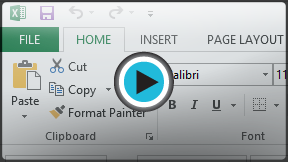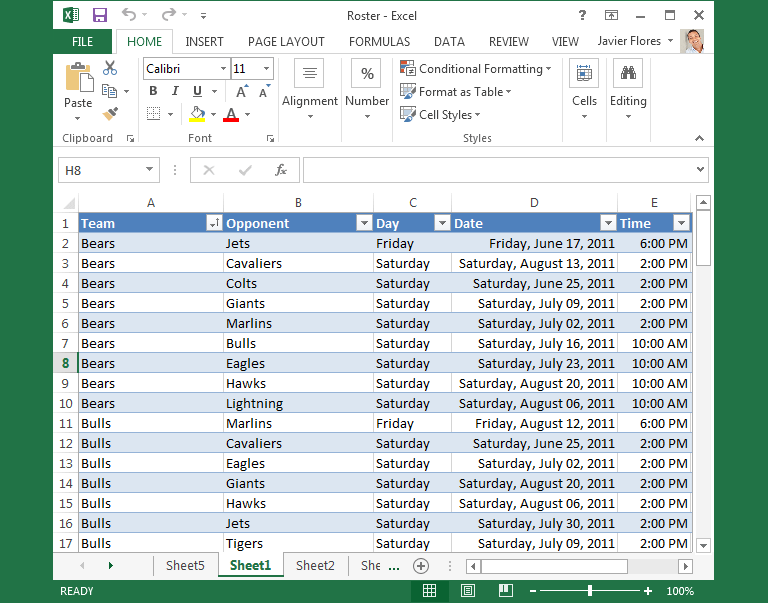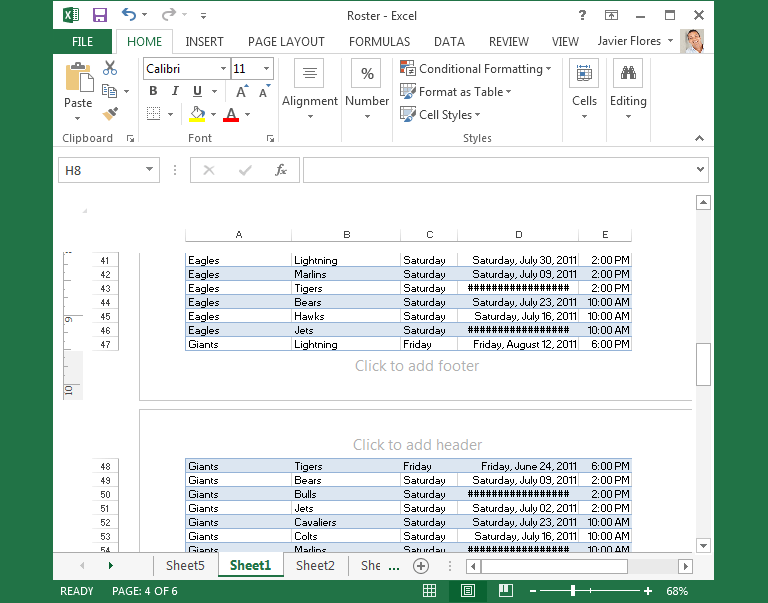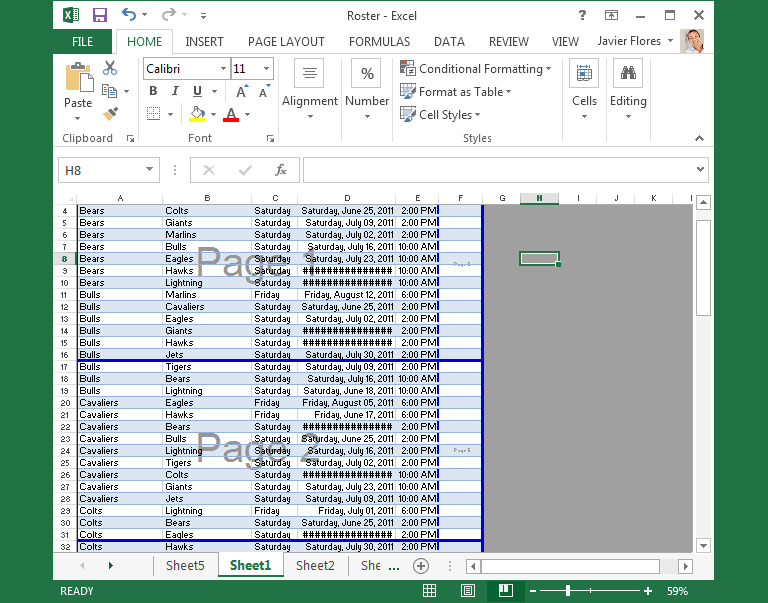Excel 2013
Getting Started with Excel
Introduction
Excel 2013 is a spreadsheet program that allows you to store, organize, and analyze information. While you may think that Excel is only used by certain people to process complicated data, anyone can learn how to take advantage of Excel's powerful features. Whether you're keeping a budget, organizing a training log, or creating an invoice, Excel makes it easy to work with different kinds of data.
Getting to know Excel 2013
Excel 2013 is similar to Excel 2010. If you've previously used Excel 2010, Excel 2013 should feel very familiar. But if you are new to Excel, or if you have more experience with older versions, you should first take some time to become familiar with the Excel 2013 interface.
The Excel interface
When you open Excel 2013 for the first time, the Excel Start Screen will appear. From here, you'll be able to create a new workbook, choose a template, and access your recently edited workbooks.
- From the Excel Start Screen, locate and select Blank workbook to access the Excel interface.
 The Excel Start Screen
The Excel Start Screen
Click the buttons in the interactive below to become familiar with the Excel 2013 interface.
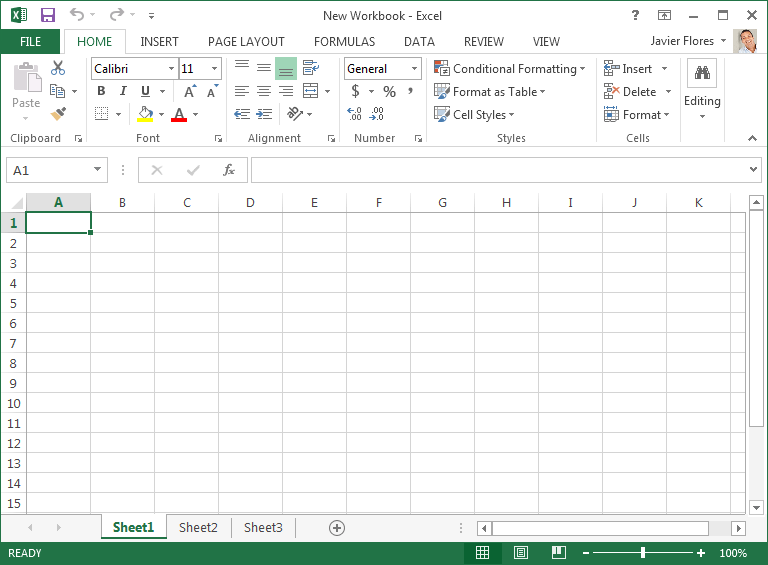
Command Group
Each group contains a series of different commands. Simply click any command to apply it. Some groups also have an arrow in the bottom-right corner, which you can click to see even more commands.
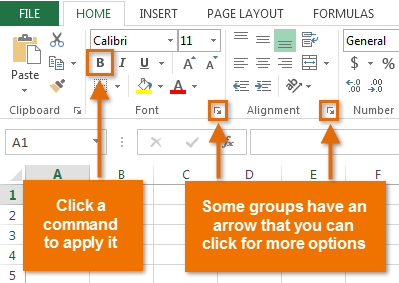
The Ribbon
The Ribbon contains all the commands you will need to perform common tasks in Excel. It has multiple tabs, each with several groups of commands.
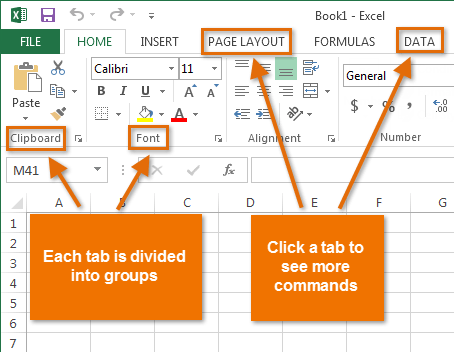
Microsoft Account
From here, you can access your Microsoft account information, view your profile, and switch accounts.

Formula Bar
In the formula bar, you can enter or edit data, a formula, or a function that will appear in a specific cell.
In the image below, cell C1 is selected and 1984 is entered into the formula bar. Note how the data appears in both the formula bar and in cell C1.

Quick Access Toolbar
The Quick Access Toolbar lets you access common commands no matter which tab is selected.
By default, it includes the Save, Undo, and Repeat commands. You can add other commands depending on your preference.

Row
A row is a group of cells that runs from the left of the page to the right. In Excel, rows are identified by numbers. Row 10 is selected in the image below.

Column
A column is a group of cells that runs from the top of the page to the bottom. In Excel, columns are identified by letters. Column H is selected in the image below.
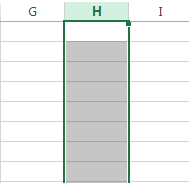
Name Box
The Name box displays the location, or "name" of a selected cell.
In the image below, cell B4 is selected. Note that cell B4 is where column B and row 4 intersect.

Vertical and Horizontal Scroll Bars
Your spreadsheet may frequently have more data than you can see on the screen at once. Click, hold and drag the vertical or horizontal scroll bar depending on what part of the page you want to see.

Zoom Control
Click and drag the slider to use the Zoom control. The number to the right of the slider reflects the zoom percentage.
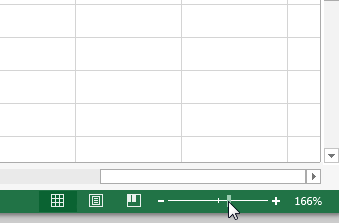
Worksheet View Options
There are three ways to view a worksheet. Simply click to select the desired view:
• Normal view is selected by default, and shows you an unlimited number of cells and columns.
• Page Layout view divides your spreadsheet into pages.
• Page Break view lets you see an overview of your worksheet, which is especially helpful when adding page breaks.
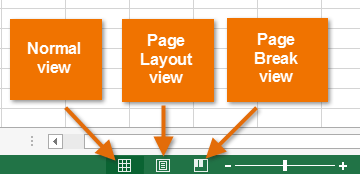
Worksheets
Excel files are called workbooks. Each workbook holds one or more worksheets (also known as "spreadsheets").
One worksheet will appear by default when you open an Excel workbook. It's easy to rename, add and delete worksheets.
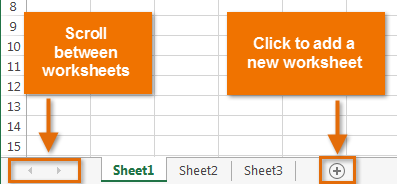
Cell
Each rectangle in a workbook is called a cell.
A cell is the intersection of a row and a column.
Simply click to select a cell. Cell B3 is selected in this example.

Working with the Excel environment
If you've previously used Excel 2010 or 2007, Excel 2013 will feel very familiar. It continues to use features like the Ribbon and Quick Access Toolbar, where you will find commands to perform common tasks in Excel, as well as Backstage view.
The Ribbon
Excel 2013 uses a tabbed Ribbon system instead of traditional menus. The Ribbon contains multiple tabs, each with several groups of commands. You will use these tabs to perform the most common tasks in Excel.
Click the arrows in the slideshow below to learn more about the different commands available within each tab on the Ribbon.
Certain programs, such as Adobe Acrobat Reader, may install additional tabs to the Ribbon. These tabs are called Add-ins.
To minimize and maximize the Ribbon:
The Ribbon is designed to respond to your current task, but you can choose to minimize it if you find that it takes up too much screen space.
- Click the Ribbon Display Options arrow in the upper-right corner of the Ribbon.
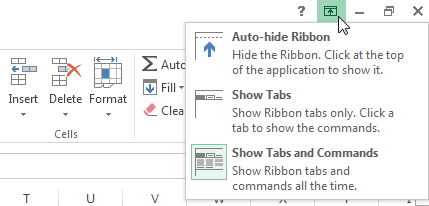 Ribbon Display options
Ribbon Display options - Select the desired minimizing option from the drop-down menu:
- Auto-hide Ribbon: Auto-hide displays your workbook in full-screen mode and completely hides the Ribbon. To show the Ribbon, click the Expand Ribbon command at the top of screen.
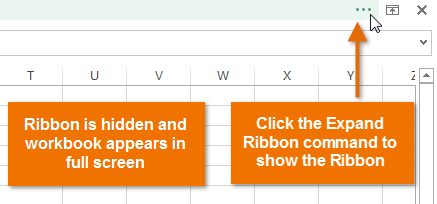 Auto-hiding the Ribbon
Auto-hiding the Ribbon - Show Tabs: This option hides all command groups when not in use, but tabs will remain visible. To show the Ribbon, simply click a tab.
 Showing only Ribbon tabs
Showing only Ribbon tabs - Show Tabs and Commands: This option maximizes the Ribbon. All of the tabs and commands will be visible. This option is selected by default when you open Excel for the first time.
- Auto-hide Ribbon: Auto-hide displays your workbook in full-screen mode and completely hides the Ribbon. To show the Ribbon, click the Expand Ribbon command at the top of screen.
To learn how to add custom tabs and commands to the Ribbon, review our Extra on Customizing the Ribbon.
To learn how to use the Ribbon with touch-screen devices, review our Extra on Enabling Touch Mode.
The Quick Access Toolbar
Located just above the Ribbon, the Quick Access Toolbar lets you access common commands no matter which tab is selected. By default, it includes the Save, Undo, and Repeat commands. You can add other commands depending on your preference.
To add commands to the Quick Access Toolbar:
- Click the drop-down arrow to the right of the Quick Access Toolbar.
- Select the command you wish to add from the drop-down menu. To choose from more commands, select More Commands.
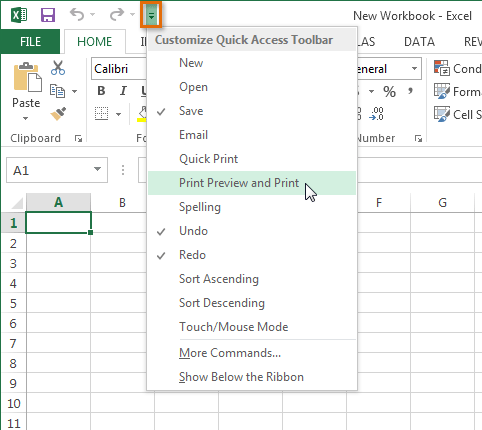 Adding a command to the Quick Access Toolbar
Adding a command to the Quick Access Toolbar - The command will be added to the Quick Access Toolbar.
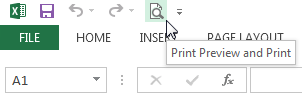 The added command
The added command
Backstage view
Backstage view gives you various options for saving, opening a file, printing, or sharing your workbooks.
To access Backstage view:
- Click the File tab on the Ribbon. Backstage view will appear.
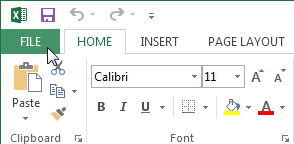 Clicking the File tab
Clicking the File tab
Click the buttons in the interactive below to learn more about using Backstage view.
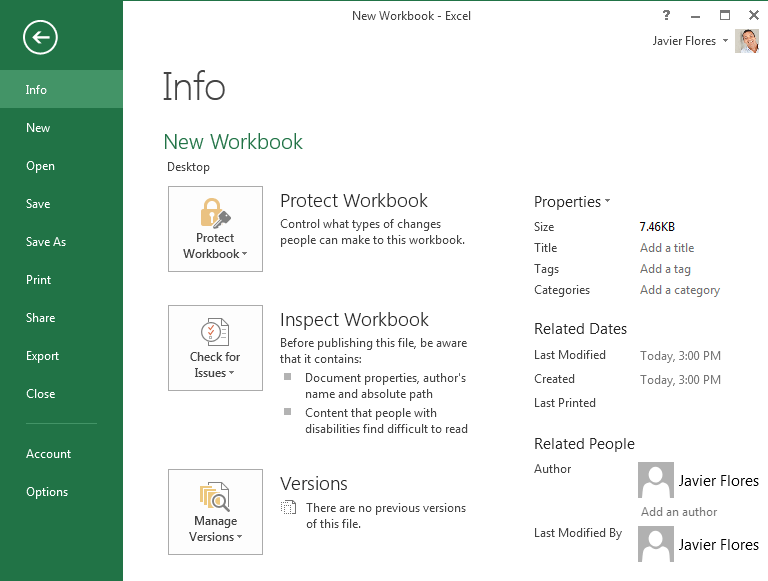
Info
The Info pane will appear whenever you access Backstage view.
It contains information about the current workbook. You can also inspect the workbook and set protection controls.
New
From here, you can create a new, blank workbook, or choose from a large selection of templates.
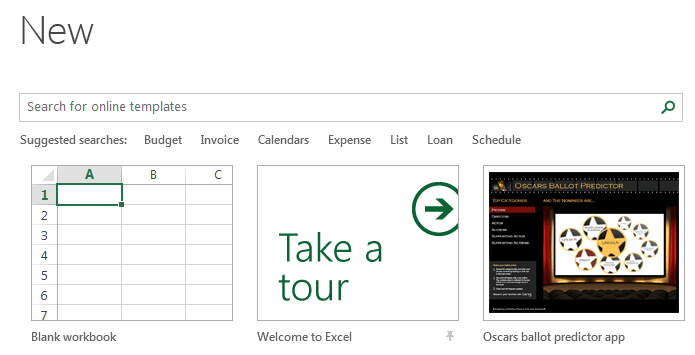
Open
From here, you can open recent workbooks, as well as workbooks saved to your OneDrive or on your computer.
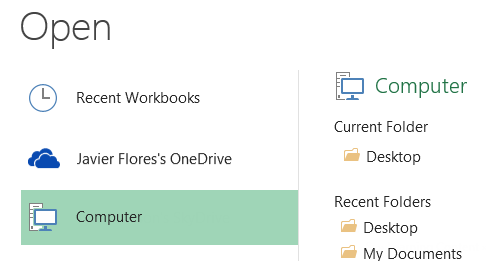
Save and Save As
Use Save and Save As to save your workbook to your computer or to your OneDrive.
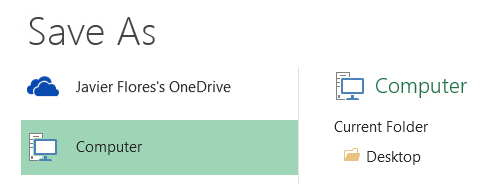
From the Print pane, you can change the print settings and print your workbook. You can also see a preview of your workbook.

Share
From here, you can invite people to view and collaborate on your workbook. You can also share your workbook by emailing it as an attachment.
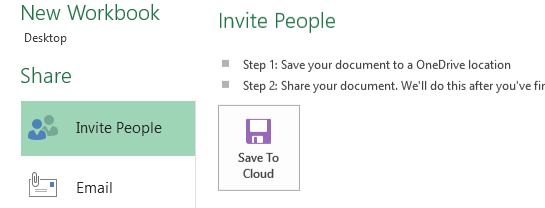
Export
You can choose to export your workbook in another format, such as PDF/XPS or Excel 1997-2003.

Close
Click here to close the current workbook.
Account
From the Account pane, you can access your Microsoft account information, modify your theme and background, and sign out of your account.
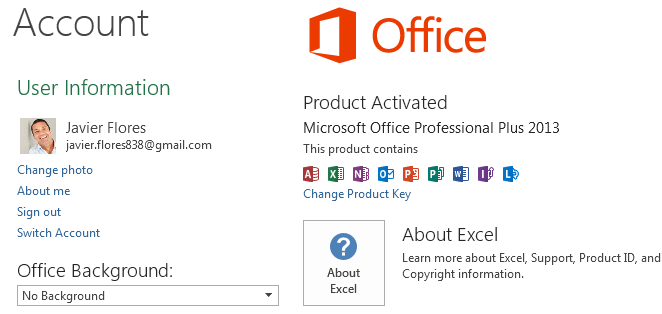
Options
Here you can change various Excel options. For example, you can control the Quick Analysis preferences, AutoRecover settings, or Language preferences.
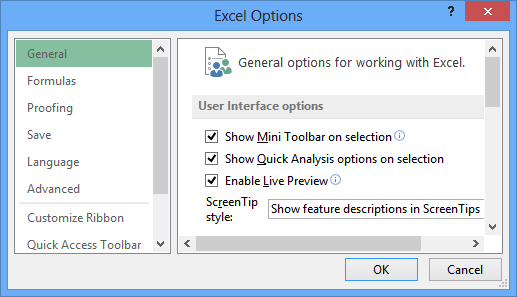
Return to Excel
You can use the arrow to close Backstage view and return to Excel.
Worksheet views
Excel 2013 has a variety of viewing options that change how your workbook is displayed. You can choose to view any workbook in Normal view, Page Layout view, or Page Break view. These views can be useful for various tasks, especially if you're planning to print the spreadsheet.
- To change worksheet views, locate and select the desired worksheet view command in the bottom-right corner of the Excel window.
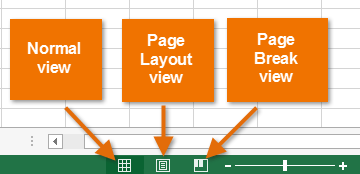 Worksheet view options
Worksheet view optionsClick the arrows in the slideshow below to review the different worksheet view options.
Challenge!
- Open Excel 2013.
- Click through all of the tabs, and review the commands on the Ribbon.
- Try minimizing and maximizing the Ribbon.
- Add a command to the Quick Access Toolbar.
- Navigate to Backstage view, and open your Account settings.
- Try switching worksheet views.
- Close Excel (you do not have to save the workbook).



